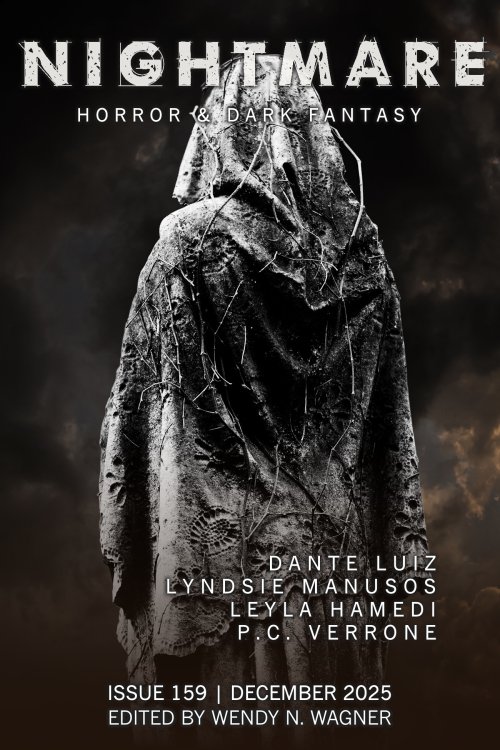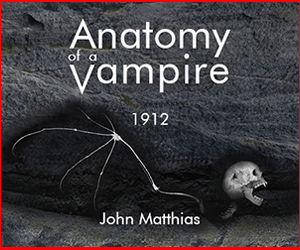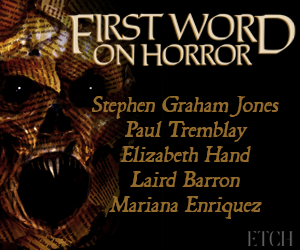I loved the metaphor of a bird in the chest as grief: We fill gaps in our hearts with what we can, but it still pokes us. Was there anything specific that inspired this image for you?
Believe it or not, it all started as a pun. I read a description somewhere of a bird species being “cavity nesters,” and my brain immediately went “you mean like thoracic cavity?” That then gave rise to the line “they nest in hollows—do you feel hollow?” and the double meaning felt interesting enough that I wrote it down.
But then it sat there. For years. Because I didn’t have a story—I had a bit of wordplay. There was nothing I was trying to say.
Cut to New Year’s Day, 2024. At that point, I’d spent the previous six years as the full-time caretaker for my wife, who was (and remains) bedbound due to ME/CFS—also woefully inadequately named “chronic fatigue syndrome.” While ME/CFS can encompass a wide range of symptoms and disability, for my wife it means constant pain plus an inability to safely expend almost any energy without making things worse—potentially permanently. Activities like bathing herself, transporting herself to the bathroom, or even reading or watching TV are too dangerous for her at this point. On a good day, she’s able to speak for a handful of minutes. The rest of the time she has to lie still and silent. It’s a hell few of us can truly imagine.
So that was at the forefront of my mind. At the same time, I’d also been watching my father slowly lose my mother to Lewy Body Dementia. Add in the pressure of a pandemic quarantine from which my wife and I never truly emerged, and . . . well, let’s just say I wasn’t in a great headspace. It had been months since I’d drafted anything new.
But on New Year’s Day, I decided to try. And as I stumbled across that line in my notes, I realized that I understood it differently now—because I felt hollow, cored out by the constant grief and fear.
I took the old advice and wrote about what scared me, pairing the fear of living without my favorite person with that image of the bird. Yet even as I let myself wallow in the protagonist’s pain, I knew the story had to look at the whole picture—not just the loss, but what comes after. Because however hard things get, I believe we owe it to those we love—and those we lose—to not give in to despair. My wife has always been adamant that the ME/CFS that’s devoured so much of her life isn’t allowed to claim mine as well. So the story really emerged from that tension, between the weight of grief and the responsibility to keep finding joy.
Second person is often a contentious choice, but it works in this piece. What drew you to that point of view? What was the process like for writing this story?
The first story I ever tried in second person was “To Cheer as They Leave You Behind,” also published in Nightmare, and it felt like it short-circuited my brain—something about it ramped up the intensity and made it harder for me to maintain distance, as both writer and reader. Maybe that’s why so many songs are written in second person: Everything feels more personal when the singer is talking directly to you. From the very first lines, this story was always in second person. As I went on, I also really liked the way it allowed the protagonist to remain more universal—I could avoid giving them a name or gender, in hopes of putting as few identity barriers as possible between them and the reader.
One of the things I like most about short stories is that if the stars align, I can catch a feeling and hold it through the whole drafting process. This was one of those: The story took me nine days of intermittent writing and came out pretty much fully formed. When I reached the end, I stuck it in a proverbial drawer, then went and spent the next seven months writing a YA romance novel. When I came back and opened it again, I was pleasantly surprised to find there was nothing I really wanted to change.
The last thing to come together was the title. Despite being an aging emo kid, I’ve only recently given myself permission to indulge in the grandiose, James-Tiptree-style titles I adore. “Make of Your Chest a Place for Birds” hit that note . . . but also felt weirdly familiar? I googled carefully to make sure I wasn’t stealing anything, but also couldn’t really see how I could be, given the weirdness of the premise. So, I shrugged and sent it off.
And then, a few months later, I was driving around and heard They Might Be Giants singing “make a little birdhouse in your soul . . . ”
When the narrator began feeding their bird mealworms, I saw this as a representation of self-care, the kind that is often distasteful and challenging, like showering and cooking healthy food when we would rather rot in bed. Was this something you were thinking about while writing this story?
Oh my god, I love that interpretation! I wish I’d intended that!
The honest truth is that the mealworms were for Nightmare. From the moment I started writing the story, I had this gut feeling that it would be perfect for Nightmare, but I worried it wasn’t really horrific so much as depressing. The mealworms were a chance to balance out the sadness with some genuinely squirm-worthy body horror, and hopefully seat it firmly in the genre.
Your answer is way better, though.
Recovery can often include reclaiming what was lost, which we see when the narrator picks up painting again. What made you specifically choose painting for this character?
My wife is an amazing artist. Back when we first moved in together, she painted a mural across our bedroom wall, and I spent hours lying on our mattress on the floor, watching her conjure up a landscape from nothing. It’s been years now since she’s been able to paint, but I still see her blank canvases and brushes every time I walk through the room where she used to work. I’d give anything to watch her paint again, so I let the protagonist have it back.
At the same time, painting was also a perfect metaphor for what the protagonist is struggling with. I think when you lose someone, there’s a fear that the memory will fade—worse, that by allowing yourself to move forward, you make it fade. People talk about the pain of grief, but rarely about the guilt that comes with moments of not feeling the pain. The painting is about wrestling with that desperate desire to preserve every memory, but also, by the end, about realizing they’ll always be with you, and that what comes next does nothing to invalidate what’s come before.
Do you have any future work that readers can look forward to? Where can we find more of your work?
Some of my best work is right here in Nightmare! “To Cheer as They Leave You Behind” is about helicopter parenting through the lens of auto-cannibalistic time travel, while “And All Their Silent Roars” is my love letter to eighties-soaked spooky stories à la Stephen King, Joe Hill, and Are You Afraid of the Dark?.
If you want some lighter fare, though, my main work these days is writing queer young adult romance novels! Darkhearts is a band-bros, frenemies-to-lovers gay romance about falling for the boy who stole your chance to be a rock star, while The Ghost of Us is a supernatural sapphic fake-dating story starring a teenage ghost hunter who finds an actual ghost—think Ten Things I Hate About You meets Ghost. Both are available wherever you get your books (though if you check out the audiobooks, you can hear me perform the intro music!).
You can also find all my writing, game design, and more on my website at jameslsutter.com, or chat with me on Instagram at @james_l_sutter or less frequently on Bluesky at @jameslsutter. I’d love to hear from you!








